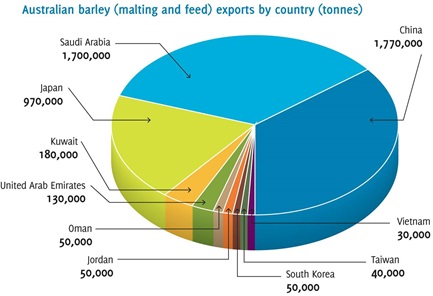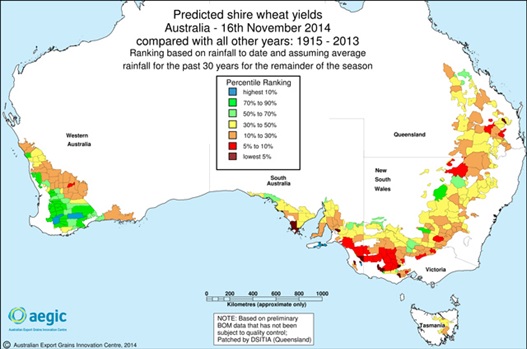Doing the right thing by growers, market and industry – it’s in your hands
Author: David Fienberg | Date: 10 Feb 2015
David Fienberg,
AEGIC.
Keywords: export, markets, wheat, barley.
Take home messages
- For advisers AEGIC is a source of information on global market demand and trends in terms of grain quality and end-use.
- AEGIC also provides seasonal yield predictions and other weather-related tools to assist growers with sowing, crop management and marketing decisions.
The role of a farm adviser now spans much more than agronomy. The modern adviser is expected to be a wealth of knowledge on topics ranging from soil health and grain marketing to succession planning and farmer health. In this presentation AEGIC Chief Executive Officer David Fienberg outlines AEGIC’s role in assisting advisers with their knowledge base of export market demand and the connection between grower varietal choice and end-market requirements. He will also introduce AEGIC’s seasonal and yield forecasting products which can also assist growers with their business decisions.
Background
AEGIC presented on grain quality and market requirements to a small audience of growers and advisers in Goondiwindi last year. At the end of the day one advisers said “I feel like the dots have been joined, and I now have the full picture.”
The adviser said this in reference to the advice he was giving his clients about variety choice. He said “while he felt confident about the agronomic performance of the varieties he was recommending he previously had no idea about their relationship with functionality for end-products in the markets they were destined for.”
AEGIC’s presentation filled this knowledge gap for him.
The adviser’s feedback was welcomed by AEGIC - it meant our presentation had been of value.
But it opened a can of worms. With advisers becoming more and more relied upon as influences for growers’ decision-making; how much, if at all, are they informed of what Australia’s international grain customers require from Australian grain and how on-farm decision can assist to meet these requirements?
If this level of awareness was low, what impact could this have on Australia’s long-term ability to service our markets?
This is where AEGIC, through this presentation, and AEGIC in general can help.
About Australian grain exports?
- Grain is Australia’s largest agricultural export contributing more than $12.89 billion to Australia’s economy per annum.
- Australia exports more than 65% of the ~26 million tonnes of wheat produced.
- Australia is the third largest wheat exporter and the largest exporter of barley in the world.
- Australian wheat export represents about 10-15% global wheat trade.
International global wheat market overview

Figure 1. Top 10 export countries for Australian wheat.
South Australian wheat production
The wheat South Australia produces is mostly classified as Australian Hard (AH) and Australian Premium White (APW). For export purposes, AH is typically traded to the Middle East for use in traditional flat breads. In comparison, APW is also sold to the Middle East but in addition, Africa and Asia for baking purposes.
International global barley market overview

Figure 2. Australian barley (malting and feed) exports by country (tonnes).
South Australian barley production
South Australian grain growers produce a high quality malting barley for the export market. The state also produces a large volume of feed barley – most of which is traded to the Middle East, notabley, Saudi Arabia.
Contemporary export grain market trends and challenges
The Australian grain export markets are dynamic. The growing affluence of the middle class across north and South East Asia (SEA) is impacting on dietary preferences, and therefore, changing the end-use requirements of our grain.
In SEA, for example, demand is growing for western-style baked goods such as breads, cakes and pastries, with a trend away from traditional rice and noodles. Australian wheat is considered ideal for the production of wet (udon and ramen) and dry (instant) noodles. However the harder, higher protein wheats of North America have gained a reputation as preferrable for baking purposes.
Through the Australian Wheat for Asian Baking project AEGIC is working with SEA millers, starting with Indoneisa, to demonstrate the performance of Australian wheat in SEA baking systems. The aim is to increase the quanity of Australian wheat in baking blends (i.e. blends with North American wheats) and therefore grow Australian wheat exports.
In China (Australia’s largest market for barley), malsters and brewers are becoming increasingly sophisticated in their selection of desired malting barley specifications. AEGIC, through the Value of barley characteristics in the China project is working to better understand China’s trends in beer segmentation and barley, malt and beer consumer quality requirements.
The project is identifying the functional requirements and technical developments needed to differentiate Australian malting barley and meet customer’s requirements in the future.
This information can then influence Australia’s pre-breeding, breeding, varietal classification and technical endeavours to ensure Australia’s barley growers are producing a product in line with market demand.
The Philippines import about 3mmt p.a.; 2mmt of which is milling wheat per annum. Unlike other SEA nations, the Philippines does not import any significant amount of Australian wheat for food purposes (only feed). The United States supplies almost all of the country’s milling wheat. The Philippines therefore represents a substantial opportunity for expanding wheat exports. AEGIC is working with the Philippines Association of Flour Millers to learn more about the market’s end-product requirements and to find avenues for increasing the value of Australian wheat in the Philippines.
What does this all mean for growers, and therefore, their advisers?
An understanding of Australia’s global grain markets and their requirements in terms of quality and functionality can assist growers when shaping their crop selection and help advisers in providing advice to growers.
As the ‘front-door’ entity for Australia’s export grains industry, AEGIC is well-positioned to assist advisers and growers with information they may require in regards to international markets and grain quality and functionallity.
Advisers and growers can subscribe to AEGIC’s monthly In the Loop newsletter to keep abreast of global grain consumption trends and what that might mean for Australian grain production.
Yield and seasonal forecasting
AEGIC also provides a range of tools that can assist growers’ business decisions, including:
- Predicted shire wheat yield maps (Figure 3)

Figure 3. Example of a predicted shire wheat yield map.
- Soil moisture maps
- Crop Prospects Report
- ENSO Summary
- Water use (production) efficiency
Advisers and growers can access these tools for no charge at aegic.org.au
About AEGIC
AEGIC was established by GRDC and the Western Australian Department of Agriculture and Food during 2012 and is headquartered in Perth. AEGIC is a national body, with the purpose of supporting the trade and use of Australian grain across the world through:
- International market engagement, and;
- Grain quality and processing technology research and development.
Key clients include stakeholders across the supply chain ranging from Australian grain producers, plant breeders, marketers and traders to millers, processors and consumers. AEGIC provides national leadership and enables collaboration and capacity building in Australia’s export grain industry with the end goal of returning enhanced value to growers.
AEGIC also specialises in:
- Yield and seasonal forecasts.
- Economic, business and supply chain analysis.
- Grain quality testing services.
- Technical training and support.
Contact details
David Fienberg
CEO AEGIC
David.fienberg@aegic.org.au
www.aegic.org.au
@AEGIC
Was this page helpful?
YOUR FEEDBACK
